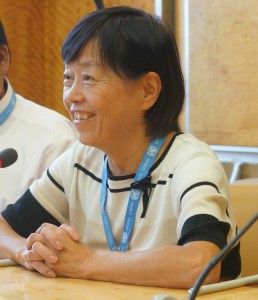2015年7月、女子差別撤廃委員会が開催されたジュネーブ国連本部。
伝統的な制度を変えようとする方向性が強いこの人権委員会と日程を同じくして、同じ国連内で開催されたJapanology学会でのエドワーズ博美氏の講演をご紹介します。
*********************************************************************************
Palais des Nations, RoomVIII in Geneva / 28th July, 2015
The World Conference of Japanology
“Merits of the Traditional Japanese Family System for Children”
Ms. Hiromi Edwards
ジュネーブ国連本部 第8会議室 2015年7月28日
ジャパノロジー学会
「伝統的日本の家族制度が子供に与えるメリット」
エドワーズ博美

Profile: Mrs. Hiromi Edwards teaches Japanese language and culture with the University of Maryland. She is a member of the American Psychological Association and has been listed in “Who’s Who in the World” since 2003. She has been writing many articles for monthly magazines of “Seiron” and “Sokoku to Seinen.” She translated three reports by the Institute of American Values and published them as a book titled “Dokushinsha wa son wo shiteiru (Singles are missing out).” She has been giving many speeches regarding the importance of family and other topics at different cities in Japan.
*********************************************************************************
*日本語版は下にあります
Merits of the Traditional Japanese Family System for Children
Hiromi Edwards
Like many things these days, family in Japan has been changing very rapidly in recent years. In 1975, the average age at which Japanese people used to get married was 27 for men and 24.7 for women, but in 2013 they are 30.9 and 29.3 respectively. The percentage of singles 20 years ago in Japan was only five percent, but in 2013 it was 20.1% for men and 10.6% for women (Gender Equality Bureau Cabinet Office). One of the most unique phenomena that is occurring in Japan among young people is called sex-less youths. According to a Cabinet Office survey, about 40% of unmarried men and woman between the ages of 20 and 30 responded that they did not want to have any lover (Sankei Shinbun dated 25 June). This phenomenon among men is called herbivorous men or grass-eating men, the word first coined by Maki Fusawa in an article published in 2006 and refers to Japanese men who are not interested in marriage or having a girlfriend. Partially as a result of this phenomenon, the number of singles are increasing rapidly in Japan. At the same time, the percentage of three-generation families is declining and many elderly persons are living alone these days.
My presentation here today isn’t about these grass-eaters or current trends, even though it can be a very interesting topic. It’s more about how Japanese families used to be like when I was growing up and why I think it is important to preserve this traditional Japanese family system.
Back then about 40 years ago when I was approaching adulthood, almost all Japanese women were expected to marry. The optimal marriage age for women was often compared to a Christmas cake, which everyone wants on the 24th or 25th but not after. So, if your household had a daughter at that age and if she did not have any prospective boyfriend, often some family friends started bringing “Omiai pictures” to the family. The same thing could happen if a son who was approaching 30 and did not have a girlfriend. Omiai is a Japanese term and often translated as arranged meetings but it’s simply an effective way to bringing together young men and women who have little opportunity to meet the opposite sex. If they decide to marry after omiai, such marriage is called “omiai marriage.” The number of “omiai marriages” tended to be larger than the number of “love marriages”, but toward the end of the 1960s the ratio was reversed and nowadays more than 90% of marriages are love marriages.
However, there is an interesting statistics, which indicates that the divorce rate of love marriages is 40% while that of omiai marriages is only 10%.
The reason the “omiai” system was established, I believe, was that Japanese society strongly believed in the marriage institution and thus family and society in general pressured young men and women to get married, have a family, and most importantly procreate a family successor.
As you can imagine, getting married in Japan is not simply tying two individuals to each other; it’s more like two families coming together and deciding which family the couple would succeed. So, the first thing we do during the formal wedding reception is the introduction of the members of each family. In the traditional Japanese family system, the most important thing for the married couple is to keep the family intact and to make sure that the family has a successor. This successor tended to be the eldest son and if there was no son in the family, the family adopted the groom into their house. Often times these newly-married couples lived with the parents whose family they succeeded. Thus, multi-generational households were not uncommon in the Japanese society even though the number is declining rapidly nowadays.
So, you may wonder why it’s so important for the family to have a successor. Is it because the family needs someone to inherit their money or assets, or carry on their family name? It may be so for some families, but the more important duty for the successor is to take care of the ancestors and their graves. The concept of family to Japanese involves not only the people we are currently living with but also many generations of ancestors before them and many generations of descendants to come. Thus, we place ancestors’ memorial tablets at the Buddhist altar inside the house, make offering to them every morning, go and visit graves on Equinox days, and receive their spirits during Bon Festival which is held in the middle of August. Ancestors are not someone deceased and forgotten but they are pretty much part of our lives and we live with them.
On top of the Buddhist altars and different customs just mentioned related to ancestors, many traditional households had and some still have a household Shinto altar and receive gods into their house. Japanese clean the house at the end of the year so that we can receive New Year’s god to the house. We visit shrines at different occasions to ask for God’s protection. Many of Japanese customs and festivals are often conducted either to respect one’s ancestors or to ask for gods’ blessing.
Accordingly, children in Japan used to grow up surrounded by many different family members as well as ancestors and gods. Why is such traditional Japanese family system good for children?
There is a think-tank called Institute for American Value in NY. They often publish many different kinds of booklet to promote family and better civil society. In 2003 they published another booklet titled “Hardwired to Connect.” The booklet is an empirical report by 33 children’s doctors, research scientists and mental health and youth service professionals. The report explains the degree of problems American children face these days and the way to solve the problems. In summary, it concludes that for the healthy growth of children they need two kinds of connectedness, to connect to other people and to spirituality.
In other words, Japanese children used to grow up in an ideal environment. They were always surrounded by many different people. Family successor took care of his/her aging parents and respected ancestors. Children grew up watching such respect. Many customs and festivals involved ancestors and gods, which evidently contributed children to understand the existence of spirit and foster their spirituality.
After WWII, many parents became busy working and children were left alone watching TV or playing video games. Many parents moved to big cities and moved away from their parents’ houses and established nucleus households. As they built their own houses, they did not care to place any Buddhist altars nor Shinto altars. Gradually, Japanese children began losing the connectedness to people and spirituality they needed. This loss of connectedness started affecting children adversely these days and our children have so much more problems nowadays which they didn’t have before.
Changes are sometimes necessary but too often such changes were brought simply because of the convenience of adults without considering the well-being of children. Traditions are here with us because they are accumulation of the wisdom of the people in the past. Some traditions can be thrown away but there are also some traditions we should hold on to. Traditional Japanese family system is one of those traditions we should hold on to and recover once again because of its merits for the children.
*********************************************************************************
日本の伝統的家族制度が子供に与えるメリット
エドワーズ博美
ほか多くのことがそうであるように、日本の家族も最近急速に変化してきています。1975年には結婚時の平均年齢が男性27歳、女性24.7歳であったのが、2013年にはそれぞれ30.9歳、29.3歳にまで上がりました。20年前の日本で独身者が全体に占める割合は5%だったのが、2013年には男性20.1%、女性10.6%になっています(内閣府男女共同参画局)。最近の日本の若者の間で起きている興味深い傾向にセックスレス現象があります。内閣府の調査では、20歳から30歳代の未婚男女の40%が恋人をもちたくないと回答しています(6月25日付産経新聞)。男性にみられるこうした現象は草食系と呼ばれ、これは2006年に発表された記事の中で深沢真紀が初めて使用した言葉で、結婚や女性に興味を示さない男性のことを指します。こうした現象の結果、日本では独身者の数が急速に増えてきています。それと同時に、3世代家族の割合は減少傾向にあり、最近では多くの年寄が一人暮らしをしています。
非常に興味深いトピックかもしれませんが、今日の私のスピーチはこうした草食系男子や最近の傾向についてではありません。今日は、私が子供時代の日本の家族はどんなもので、どうしてこの日本の伝統的家族制度を守ることが大切かについてお話したいと思います。
私が成人に達しようとしていた40年前は、ほとんどの女性は結婚するのが当たり前と思われていました。女性の結婚適齢期はよくクリスマスケーキに例えられたものです。クリスマスケーキは24日や25日にはよく売れますがそれを過ぎたら売れ残ります。こうした売れ残りを防ぐために、もし家族に25歳になるお年頃の娘がいてその子に彼氏がいなかったりすると、家族と付き合いのある友人が「お見合い写真」なるものを持ってきたりします。同じようなことは30歳になろうとする息子がいる家族でも見受けられます。お見合いという日本語はarranged meetingと英訳することができますが、これは異性に会う機会が少ない若い男女に異性と知り合うきっかけを与えるという意味では非常に効果的な制度であると言えます。もし「お見合い」の後で結婚した場合、こうし結婚は「お見合い結婚」と呼ばれます。以前は「お見合い結婚」の方が「恋愛結婚」より多かったのですが、1960年代を境にこの割合は逆転し、現在では90%以上が恋愛結婚だと言われています。
しかし、恋愛結婚の離婚率が40%に達するのに対してお見合い結婚の離婚率は10%にすぎない、という興味深い統計もあります。
なぜこうした「お見合い」制度が日本で生まれたのか。それは日本の社会が結婚制度を信じ、それゆえ家族や社会が総体的に若い男女が結婚して家族をもち、そして跡継ぎを生むように奨励したからではないかと思います。
みなさんもご存知かもしれませんが、日本において結婚するということは二人の個人の結びつきのみではなく、二組の家族が歩み寄って、新婚カップルがどちらの家の跡を継ぐのかを決定するという意味もあります。それゆえ、正式な結婚式では一番最初にお互いの家族紹介から始まります。伝統的家族制度では、結婚した夫婦にとって最も大切なことは家族を守ることもさることながら、家の跡継ぎを確保することです。この跡継ぎはほとんどの場合はその家の長男ですが、もし家族に男の子がいない場合は娘婿が妻の実家の養子になったりします。しばしばこうした跡取りは継いだ家の両親と同居したりもします。それゆえ、今ではその数は減少傾向にありますが、日本では何世代もの家族が同居する家も珍しいことではありませんでした。
ここまでお話しすると、どうして家族にとって跡継ぎを確保することがそんなに大切なのかと思われる人もいるかもしれません。 遺産や財産を相続する人が必要だからでしょうか。それとも家名を残す必要があるからでしょうか。確かにそういう面もあるかもしれません。しかし、跡継ぎにとってそれより重要な責務は先祖やお墓を大切にするということです。日本人にとっての家の概念とは、今一緒に生活している家族のみを指すのではなく、今まで何代も続いたご先祖様、そしてこれから生まれ来る子孫も含まれます。それゆえ、我々は家の仏壇にご先祖様のお位牌を置き、毎朝お位牌にお供えをし、お彼岸にはお墓参りをし、8月中旬に行われるお盆と呼ばれる行事ではご先祖様の御霊を家にお迎えします。日本人にとって先祖とは亡くなって忘れられた人ではなく、我々の生活の一部であり日本人はご先祖様と一緒に生活しているということも言えると思います。
仏壇をはじめとした先祖に関係した種々の習慣のほかにも、多くの伝統的な家では今でも神棚を置いて神仏をお迎えします。日本人は年末に大掃除をして新年に年神様をお迎えします。種々な機会にお宮参りをして神頼みをします。日本の習慣や祭りの多くはこのようにご先祖様に敬意を示したり神仏の恩恵を請うものです。
このように、日本の子供たちは多くの家族やご先祖様、それに神仏に囲まれて成長してきました。こうした日本の伝統的家族制度がどうして子供の成長にとって望ましいのでしょうか。
ニューヨークにアメリカ価値研究所というシンクタンクがあります。研究所では種々の冊子を発行して健全な家族や社会の発展に寄与しています。2003年には「Hardwired to Connect」という冊子が発行されました。この冊子は小児科医、リサーチサイエンティスト、精神科医等の33人からなるチームによる研究結果をまとめたものです。この研究は今日のアメリカの子供たちがかかえる問題の深刻さを指摘し、その問題を解決するための方策を示唆しています。そして、子供の成長には二種類の関係、いわゆる人との関係、それに精神的何かとの関係が必要であると結論付けています。
言い換えれば、日本の子供たちは理想的な環境で育ってきたということが言えます。子供たちは大家族制度の中でいつも多くの人たちに囲まれていました。跡継ぎは年老いた両親の世話をし、ご先祖様を敬ってきました。子供たちはこうした年寄りや神仏に対する敬意を見て育ちました。多くの習慣やお祭りがご先祖様や神仏に関係したもので、こうした習慣を通して子供たちは御霊の存在を理解し精神性が培われました。
第二次大戦後、多くの親は仕事が忙しく、子供たちは一人取り残されてテレビを見たりビデオゲームをして過ごすようになりました。多くの親が都会に引っ越し、田舎に年寄を置いて核家族を形成していきました。自分の家を建てたとき、そこには仏壇や神棚はありませんでした。徐々に、日本の子供たちは子供にとって必要な人との関係や精神性を失い始めました。今日、この関係の喪失が子供たちに悪影響を与え始め、以前は経験しなかったような問題を子供たちは今、抱えています。
時には変化が必要な時もあります。しかし、多くの場合、こうした変化は大人の都合を優先し子供にとって何が大切であるかの考慮が抜け落ちています。伝統は過去の人々の叡智の結集です。 捨て去っていい伝統もあるかもしれませんが、多くの伝統はいつまでも大切に持続すべきものです。日本の伝統的家族制度も子供たちに与えるメリットを考慮したとき、持続すべきものであり今一度取り戻す必要のあるものの一つです。

なでしこアクションのマダム方頑張れ
外務省は無能だから、期待してます
なでしこアクションの皆さんの活動に心から敬意を表します。
これからも皆さんの活動を全面的に支持、応援したいと思います。